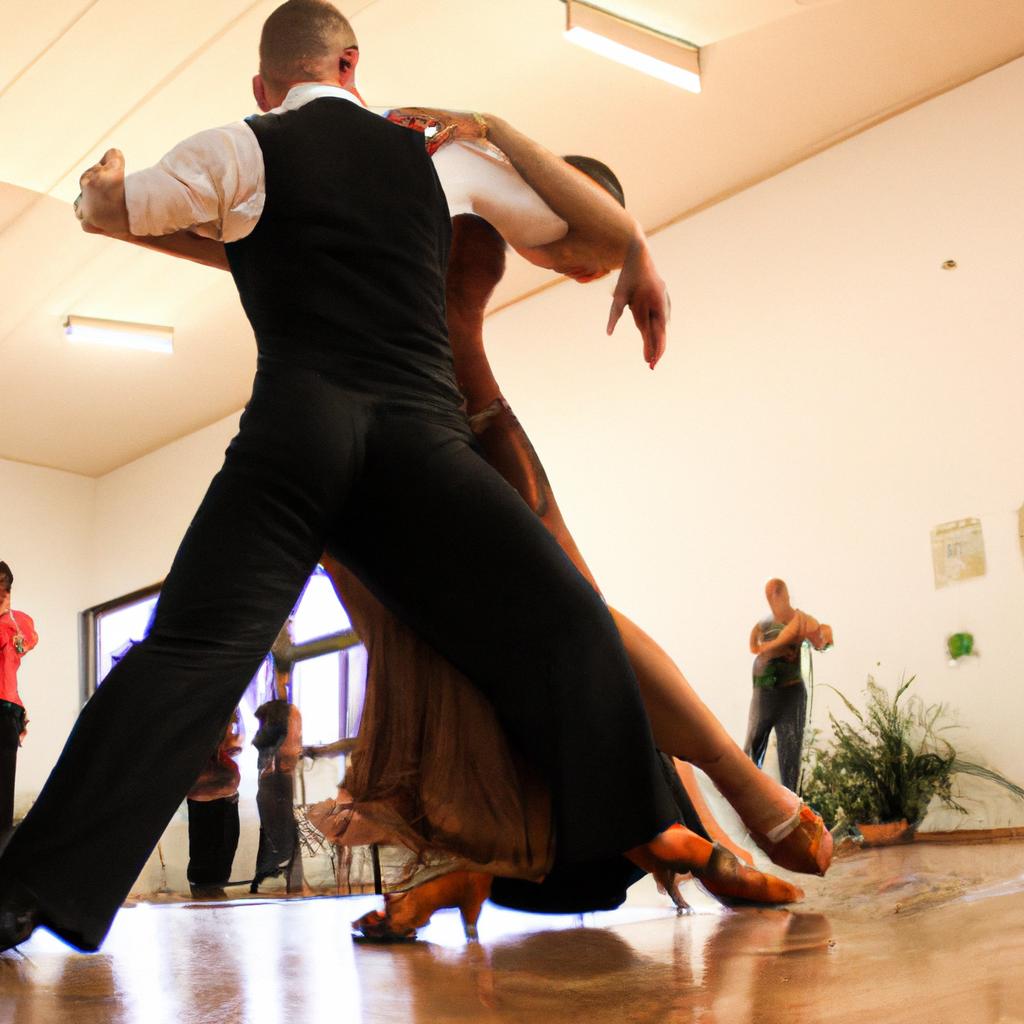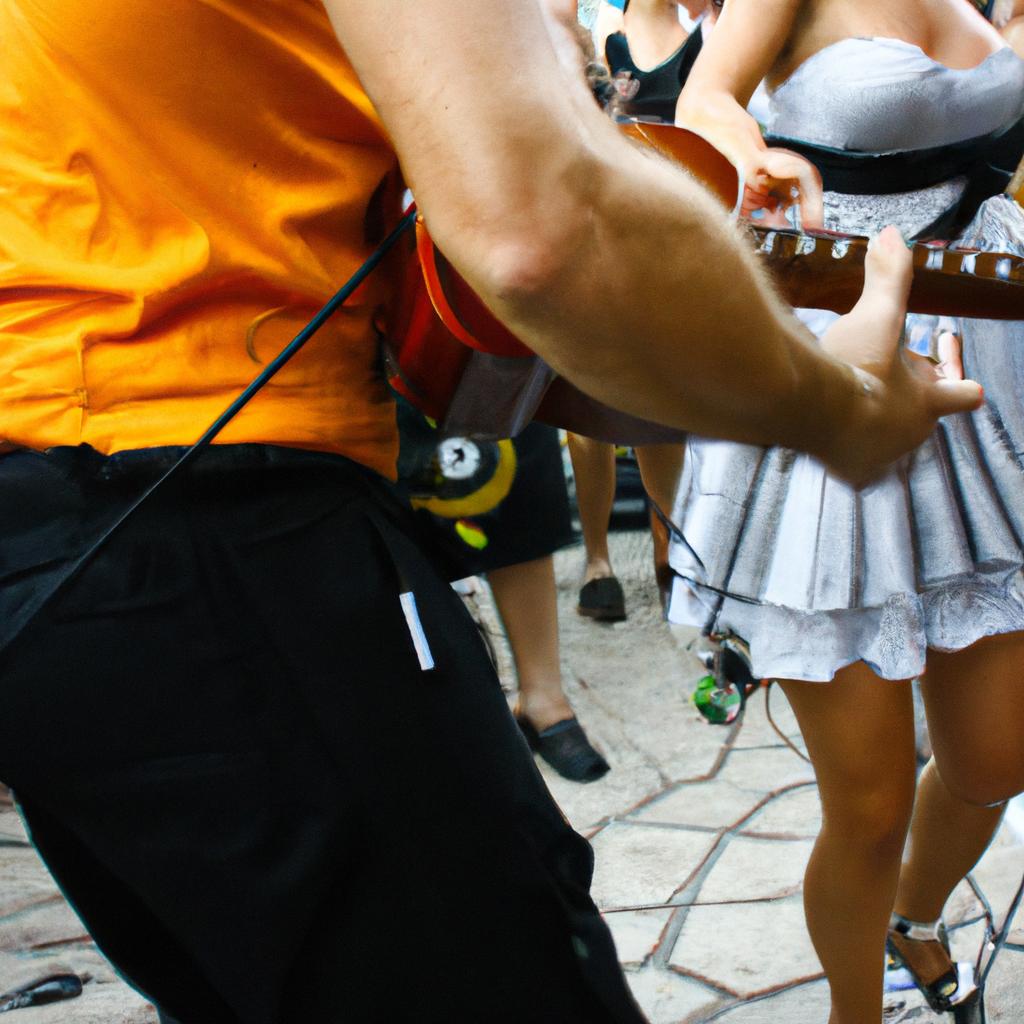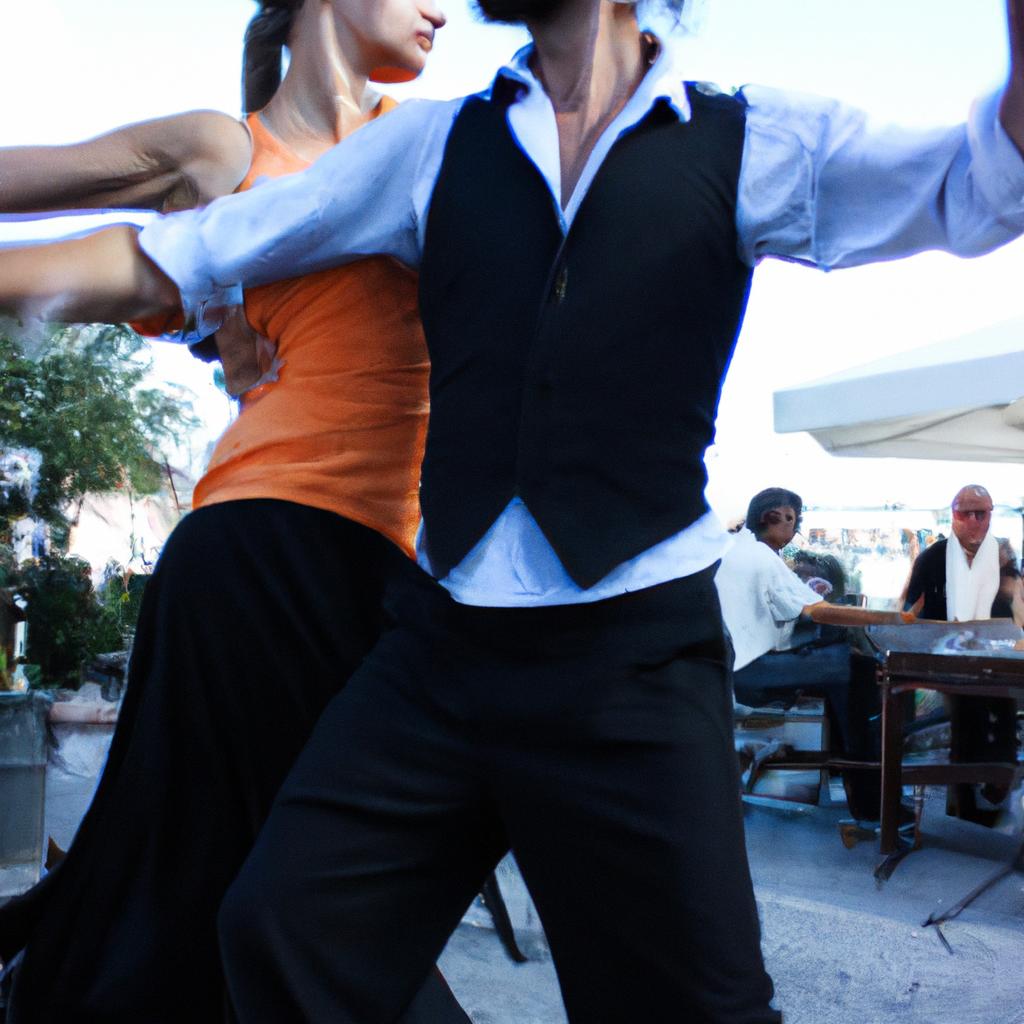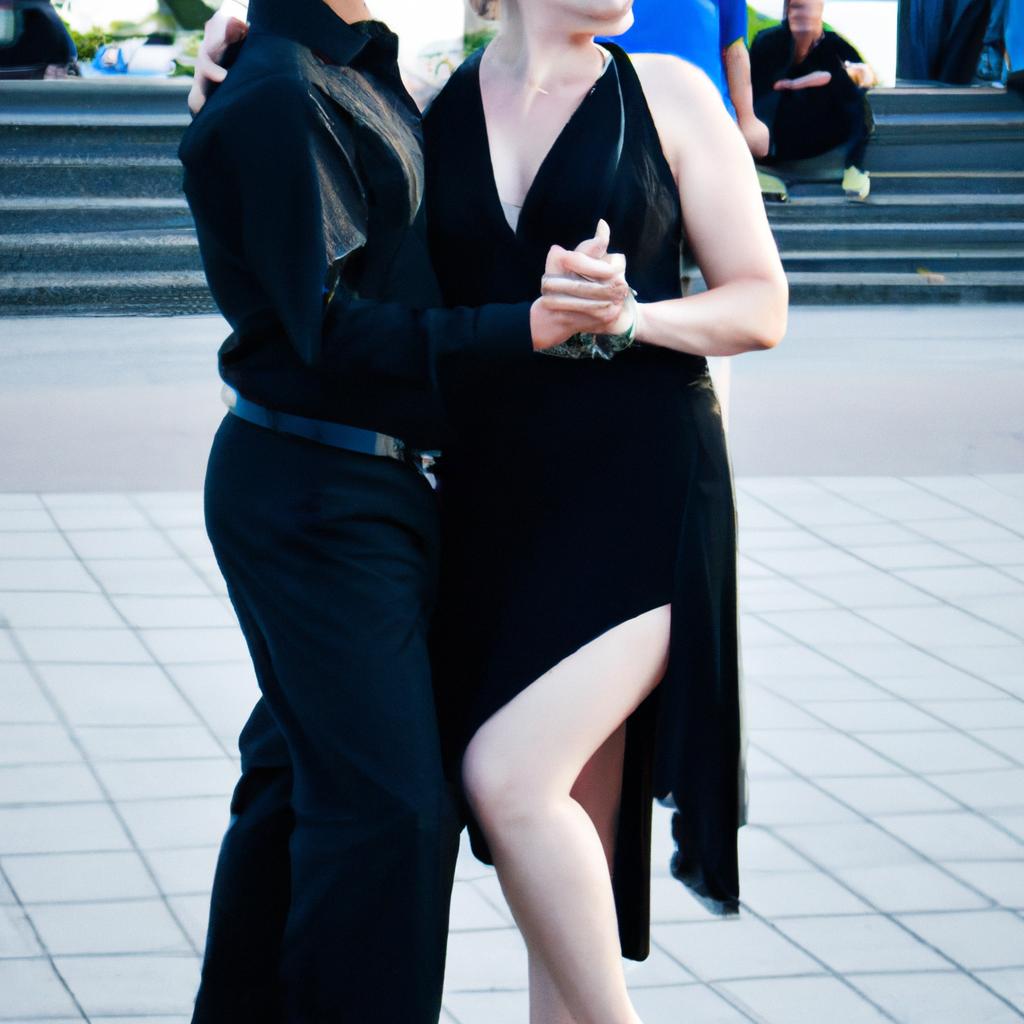The tango, a renowned dance form originating in the late 19th century from the streets of Buenos Aires, Argentina, has captivated audiences worldwide with its passionate and intricate movements. While commonly associated with dramatic footwork and elegant partnering, it is important to recognize the integral role that music plays in shaping the overall experience of this art form. In particular, the choice of tango instrument can greatly influence the style and mood of a ballroom tango performance.
Consider for instance a hypothetical scenario where two professional ballroom dancers are preparing for an international competition. One dancer selects a traditional tango orchestra arrangement featuring a bandoneón as the lead instrument, while the other opt for a modern interpretation using electronic synthesizers. Despite both interpretations being technically proficient, their choices create distinct atmospheres on the dancefloor. The first dancer’s use of live musicians evokes nostalgia and authenticity, transporting spectators back to Tango’s early roots. On the other hand, the second dancer’s unconventional approach infuses elements of contemporary flair and experimentation into their routine.
History of Tango Music
Imagine yourself in the vibrant streets of Buenos Aires, Argentina in the late 19th century. The sultry sounds of the bandoneón fill the air as couples gracefully glide across the dance floor, moving to the rhythm of tango music. This iconic genre originated from a fusion of European and African musical traditions, creating a unique expression that captivated audiences worldwide.
Tango music emerged during a time when waves of immigration brought people from various cultures together in Buenos Aires. As these diverse communities intermingled, their distinct musical styles blended harmoniously to form what we now recognize as tango. Drawing inspiration from genres such as milonga and habanera, tango incorporated elements like syncopated rhythms and melancholic melodies to convey an array of emotions.
To fully appreciate the depth and richness of tango music, let us explore its historical development through three key phases:
- Early Origins (Late 19th Century): Tango began its journey in marginalized neighborhoods where immigrants sought solace amidst challenging living conditions. Born out of necessity and resilience, this early form of tango served as an emotional outlet for those yearning for connection and escape from their everyday struggles.
- Golden Age (1930s-1950s): During this period, tango experienced widespread popularity both within Argentina and internationally. Orchestras led by legendary figures such as Juan D’Arienzo and Carlos Di Sarli mesmerized listeners with their virtuosic performances. It was also during this era that vocalists like Carlos Gardel rose to stardom, adding lyrical narratives to enhance the storytelling aspect of tango.
- Modern Revival (1980s-present): After a decline in popularity following the Golden Age, tango experienced a revival thanks to musicians like Astor Piazzolla who introduced innovative interpretations while still respecting traditional roots. Today, tango continues to evolve with contemporary artists experimenting with electronic elements and collaborating with musicians from diverse genres.
Emotions evoked by tango music:
- Passion
- Longing
- Nostalgia
- Intimacy
| Emotion | Description |
|---|---|
| Passion | Tango’s fiery rhythms and expressive melodies ignite a passionate energy within the listeners, stirring their souls. |
| Longing | The melancholic undertones of tango evoke a sense of longing, transporting individuals to an emotional realm where desires are laid bare. |
| Nostalgia | Tango’s nostalgic essence allows people to reminisce about past experiences or long-lost moments, invoking a bittersweet longing for what once was. |
| Intimacy | Through its intricate dance movements and heartfelt musical expressions, tango creates an intimate connection between dancers and the audience alike, forging bonds beyond words. |
As we delve further into the world of tango, let us now explore the different types of instruments that contribute to this captivating genre. These instruments play distinctive roles in shaping the overall sound and mood of tango compositions without overpowering one another.
[Transition sentence] Moving forward, we will explore the fascinating array of instruments that bring life to the enchanting world of tango.
Different Types of Tango Instruments
Transitioning from the previous section on the history of Tango music, it is important to explore the different types of Tango instruments. These instruments play a vital role in creating the unique and captivating sound that accompanies Tango dances. Understanding these instruments can provide insight into how they contribute to the overall experience of Ballroom Tango.
One example of a popular Tango instrument is the bandoneón. This button accordion-like instrument is known for its melancholic tone and has become synonymous with traditional Argentine Tango. The bandoneón’s expressive capabilities allow musicians to convey emotions through their playing, adding depth and intensity to the dance. Its distinct sound resonates with both performers and listeners alike, enhancing the emotional connection between dancers and music.
To further illustrate the significance of Tango instruments in Dance: Ballroom Tango, consider the following bullet points:
- Instruments such as guitars, violins, pianos, and double basses are commonly used in tango ensembles.
- Each instrument brings its own unique timbre and tonal qualities, enriching the overall texture of the music.
- The interplay between these instruments creates intricate melodies and harmonies that guide dancers’ movements.
- The rhythmic patterns produced by percussion instruments like drums or tambourines establish a strong beat for dancers to follow.
In addition to bullet points, exploring this topic can be enhanced by visual aid. Here is an evocative table showcasing some common Tango instruments along with their characteristics:
| Instrument | Characteristics |
|---|---|
| Bandoneón | Melancholic tone |
| Guitar | Provides harmonic foundation |
| Violin | Expressive melodic lines |
| Piano | Adds richness and depth |
By understanding these various elements within a Tango ensemble, one can appreciate how each instrument contributes uniquely towards creating an immersive musical experience during Ballroom Tango dances.
As we delve into the importance of Tango instruments in Dance: Ballroom Tango, it becomes evident that these instruments serve as the foundation upon which dancers build their movements and emotions. The intricate melodies, harmonies, and rhythmic patterns generated by these instruments establish a strong connection between the music and dance. This seamless integration allows for a symbiotic relationship to form, where both dancers and musicians feed off each other’s energy, creating an unforgettable experience for all involved.
With an understanding of how Tango instruments shape the dance itself, we can now explore the importance they hold in enhancing the overall experience of Ballroom Tango.
Importance of Tango Instrument in Dance
Tango instruments play a crucial role in enhancing the overall experience and ambiance of ballroom tango dance. Their distinctive sounds, rhythms, and melodies create an immersive environment that invites dancers to express themselves with grace and passion. To understand the importance of these instruments in ballroom tango, let’s explore their various functions and effects.
One example illustrating the significance of tango instruments is the bandoneón, a concertina-like instrument commonly associated with traditional Argentine tango music. Its melancholic and haunting sound sets the emotional tone for dancers as they move across the dance floor. This powerful combination often evokes a sense of longing, creating a captivating atmosphere that draws both performers and spectators into its embrace.
In addition to the bandoneón, other key instruments such as the piano, violin, and double bass contribute to the richness of ballroom tango music. Here are some ways in which these instruments impact the dance:
- Rhythmic foundation: The steady beats provided by instruments like the piano or double bass establish a strong rhythmic foundation for dancers to synchronize their movements.
- Melodic embellishment: Violins add melodic flourishes that enhance the expressive qualities of ballroom tango, allowing dancers to interpret intricate musical phrases through their choreography.
- Dynamic contrast: Tango instruments effectively employ dynamics (loudness or softness) to create tension and release throughout a performance. These shifts in volume heighten emotions within dances, intensifying moments of connection between partners.
- Collaborative interplay: In ensemble performances, each instrument has its unique voice but works together harmoniously. This collaborative interplay generates layers of complexity within ballroom tango compositions, inspiring dancers to adapt their movements accordingly.
To further illustrate this dynamic relationship between tango instruments and dance forms, consider the following table:
| Instrument | Function | Emotional Effect |
|---|---|---|
| Bandoneón | Sets the mood | Elicits longing |
| Piano | Establishes rhythm | Provides stability |
| Violin | Adds melodic embellishment | Enhances expressiveness |
| Double bass | Creates depth and resonance | Evokes sensuality |
In conclusion, tango instruments are essential components of ballroom tango dance. They create a captivating environment that allows dancers to fully immerse themselves in their performances. The unique sounds and effects produced by these instruments serve as catalysts for emotional expression, enabling dancers to convey passion, longing, and sensuality through their movements.
Transitioning seamlessly into the subsequent section about “Key Features of Ballroom Tango,” we now delve into the specific elements that make this dance style so enchanting.
Key Features of Ballroom Tango
Section Transition:
Building upon the significance of tango instruments in dance, let us now delve into the key features that distinguish the captivating ballroom tango. By exploring its unique characteristics and examining specific elements, we can gain a deeper understanding of this elegant dance form.
To illustrate the distinctiveness of ballroom tango, consider an example where a couple gracefully moves across the floor, their steps synchronized to the rhythmic beat of passionate music. This exemplifies one hallmark feature—precision. Ballroom tango demands meticulous footwork as dancers execute intricate patterns with utmost precision, emphasizing clean lines and sharp movements. The synchronicity between partners creates an atmosphere filled with intensity and allure.
The emotional essence of ballroom tango is further enhanced by several key elements:
-
Posture and Body Alignment:
- Maintaining an upright posture with strong core engagement
- Creating a connection through frame alignment for seamless communication between partners
- Conveying confidence and elegance through body language
-
Intimate Connection:
- Establishing a close physical proximity while maintaining personal space boundaries
- Building trust and harmony through subtle cues conveyed via gentle pressure or weight shifts
- Developing a deep sense of partnership that allows for fluidity in movement
-
Musicality:
- Sensitively interpreting various rhythms within tango music
- Incorporating pauses, dips, and dramatic accents to highlight musical phrasing
- Infusing individual expression while remaining connected to the overall composition
-
Expressive Dynamics:
- Utilizing contrasts in speed, energy, and intensity to convey emotions such as passion,
longing, or sensuality - Balancing controlled movements with moments of release to create tension and anticipation
- Captivating audiences through intricate leg flicks, swift turns, and dynamic promenades
- Utilizing contrasts in speed, energy, and intensity to convey emotions such as passion,
The amalgamation of these elements establishes ballroom tango as a mesmerizing dance form that embodies precision, emotional depth, and captivating dynamics. As dancers skillfully navigate the intricate footwork while maintaining an intimate connection with their partners, they create a visually stunning display that captivates both participants and observers alike.
With a thorough understanding of the key features distinguishing ballroom tango, we can now explore the vital role music plays in shaping this enchanting dance style.
Role of Music in Ballroom Tango
From Key Features of Ballroom Tango to Role of Music in Ballroom Tango
One remarkable aspect of ballroom tango is the profound influence that music has on its execution. The rhythm, tempo, and mood of the chosen music greatly shape the dancers’ movements and overall performance. As an illustration, imagine a couple gracefully gliding across the dance floor, their synchronized steps perfectly timed with each beat of the music. This harmonious union between movement and melody epitomizes the essence of ballroom tango.
To delve deeper into the role of music in ballroom tango, let us explore some key factors that contribute to this symbiotic relationship:
- Rhythm: The rhythmic structure provides a solid foundation for dancers to synchronize their steps. In ballroom tango, a prominent 8-count pattern prevails, guiding dancers through a series of precise footwork sequences.
- Tempo: The tempo dictates the speed at which dancers navigate through various figures and patterns. Slower tempos allow for more intricate movements and expressive pauses, while faster tempos demand quick footwork and agility.
- Melody: The melodic elements enhance the emotional connection between partners by conveying different moods such as passion, longing, or excitement. Dancers utilize these musical cues to express themselves artistically during performances.
- Phrasing: Understanding phrasing within the music assists dancers in interpreting breaks, accents, and changes in intensity. By incorporating these nuances into their choreography, couples can create captivating moments that captivate both judges and spectators alike.
Emotions run high when engaging in ballroom tango; it is not solely about executing well-rehearsed moves but also about evoking feelings from those involved. To illustrate this point further, consider how different aspects of ballroom tango can elicit emotions:
| Emotion | Aspect |
|---|---|
| Excitement | Quick, energetic tempo |
| Passion | Intense, dramatic music |
| Serenity | Slow-paced melodies |
| Joy | Upbeat and lively rhythm |
As dancers interpret these emotions through their movement, the audience becomes captivated by the evocative nature of ballroom tango.
In the upcoming section on “Tips for Mastering Ballroom Tango with Tango Instrument,” we will explore practical strategies to improve your tango skills while incorporating specific techniques inspired by this fascinating dance style.
Tips for Mastering Ballroom Tango with Tango Instrument
Having discussed the significance of music in ballroom tango, we now turn our attention to exploring some practical tips for mastering this dance with the assistance of a tango instrument. To illustrate these tips, let us consider the case study of Alex and Maria, two aspiring ballroom dancers who have recently started learning the art of tango.
Tip 1: Selecting the Right Tango Instrument
- A good starting point is choosing a suitable tango instrument that complements your style and preferences.
- Consider options such as bandoneon, piano, or violin, each offering distinct tonal qualities and musical versatility.
- Experiment with different instruments to find one that resonates well with your personal expression and enhances your overall performance.
Tip 2: Developing Rhythmic Sensitivity
- Mastery of ballroom tango requires developing an acute sense of rhythm.
- Practice counting beats accurately by using metronomes or rhythmic aids during rehearsals.
- Cultivate an understanding of various rhythms within tangos, such as those found in Argentinean traditional tangos versus modern interpretations.
To truly immerse oneself in the world of ballroom tango with a tango instrument:
- Feel the pulsating beat resonate through your body.
- Embrace every step with passion and intensity.
- Allow the melodies to guide your movements effortlessly.
- Experience a harmonious connection between mind, body, and sound.
Case Study Table:
| Tip | Description |
|---|---|
| Selecting the Right Instrument | Choose an instrument that complements your style |
| Developing Rhythmic Sensitivity | Cultivate an acute sense of rhythm |
Incorporating these tips into their practice sessions, Alex and Maria gradually developed their skills in tandem with their chosen instruments. Their synchrony improved as they embraced not only technical aspects but also the emotional nuances conveyed through their music. Through diligent practice and dedication, they soon found themselves immersed in a captivating dance that transcended mere steps and became an expression of their shared passion.
By understanding the role of music in ballroom tango and incorporating the tips provided above, individuals can elevate their dance experience, creating a harmonious connection between movement and sound. So let your chosen tango instrument guide you on this enchanting journey, as you explore the depths of emotion evoked by each note and step along the way.




